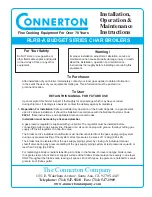
TROUBLESHOOTING
8-4
wire #138 on the unit. Also check continuity
between wire #60 in the control panel and
the unit shell.
5. If there is no continuity repair as necessary.
If there is continuity replace the low water
level circuit board.
8.4 HIGH WATER TEMPERATURE
8.4.1 Determining the Cause
8.4.2 Over Temperature Limit Switches
8.4.3 Other Causes
All Benchmark units ship with a manual reset,
temperature limit switch that is fixed at 210
0
.
Only recently, as of unit S/N G-0-711 and above,
have units begun shipping with an adjustable,
auto restart, temperature switch as well as the
manual reset switch. A high water temperature
fault indicates that the unit’s discharge water
temperature has exceeded the setpoint of one or
both temperature limit switches. The following
procedure will help in troubleshooting and
determining the source of the high discharge
water temperature.
Recommended Troubleshooting Equipment
•
Digital Voltmeter/Digital Ohmmeter (DVM)
8.4.1 DETERMINING THE CAUSE
1. To aid in troubleshooting, remove the unit’s
right and left side sheet metal panels to
expose the over-temperature switches and
their associated wiring
2.
Using either the temperature controller or
system thermometers, as indicators ,
determine if the unit’s discharge water
temperature is greater than 200
0
.
3. If the discharge water temperature is less
than 200 degrees, depress the reset button
on the manual over-temperature switch and
then try to clear the anunnciator display and
restart the unit. If the display does not clear
and the unit does not restart, proceed to
step 5.
4. If the discharge water temperature is greater
than 200 degrees, it will be necessary to
wait until the discharge water temperature
has dropped below 200 degrees. Once the
temperature has dropped, depress the
manual temperature switch reset button,
clear the annunciator display, and restart the
unit. If the display does not clear and the
unit does not restart proceed to step #5.
(Note: It may be necessary to wait until the
temperature has dropped 20 degrees or
more before the temperature switch will
reset.)
5. Check to see if the unit has an adjustable
temperature switch. If it does, ensure that
it’s setting is not less than the discharge
water temperature.
6. If the adjustable temperature switch setting
is lower than the current water temperature,
raise its setting until it is above the current
water temperature and try to clear the fault.
If the fault persists, proceed to section 8.4.2
8.4.2 OVER TEMPERATURE LIMIT
SWITCHES
1. Disconnect AC power to the unit.
2. Remove the boiler's right side and left side
panels to expose the over temperature limit
switches and their associated wiring.
3. Locate the over temperature limit switch or
switches. Remove wires #136 and #137
from the temperature switch or switches.
4. If there are two temperature switches, check
for continuity across the P and #2 terminals
of each switch. If there a single temperature
switch, check for continuity between the # 1
and #2 terminals. (Be sure that the
discharge water temperature is well below
the switches trip temperature before
checking continuity.)
5. Replace any switch that does not show
continuity.
6. If the switch or switches are okay, open the
control panel door and locate the 120 VAC
hot and neutral terminal blocks located
under the shelf and just to the right of the
transformer. Locate wire #117 on the hot
terminal block. Perform a continuity check
from wire #117 to wire #137 at the
temperature switch or switches.
7. Next locate wire number #153 at the low
pressure gas switch and measure continuity
from wire #153 to wire # 136 at the
temperature switch or switches.
Note:
The procedures in steps 6 and 7 test
and ensure the integrity of wiring inside and
outside of the control panel as well as the
connections of the control box connectors.
Summary of Contents for Benchmark G-00-711
Page 62: ...APPENDIX C ix Temperature Sensor Resistance Chart Balco ...
Page 69: ...APPENDIX F xvi ...
Page 70: ...APPENDIX F xvii ...
Page 71: ...APPENDIX F xviii ...
Page 72: ...APPENDIX F xix ...
Page 73: ...APPENDIX F xx ...
Page 74: ...APPENDIX G xviii ...
Page 75: ...APPENDIX G xix ...
Page 76: ...APPENDIX H xxi ...
















































